There is quite a bit involved in targeting Tuna and many aspects to discuss, but I will mostly be touching on how to catch them by trolling. My experience of Tuna only extends to models up to 30kg both land based and from boats. I would like to land a big barrel Tuna just once in my lifetime, which is doable as they do turn up out in the ocean near where I live. I am happy however, to share what experience and knowledge I have gained in targeting these amazing pelagic fish.
The first Tuna I ever caught were in Portland in the winter months, where I’d put in my annual leave and make the trek down to head out on a charter boat. Usually I was the only female, which was character building at times!
In recent years I’ve travelled to Port MacDonnell, to go out on a charter with my partner Terry and we would bring our catch all the way back home iced up in a portable fridge, as it was a 6.5 hr trip. Going on charters was a great learning curve as to how everything comes in to play, from the gear to the indicators to look out for to how you land and look after your fish.
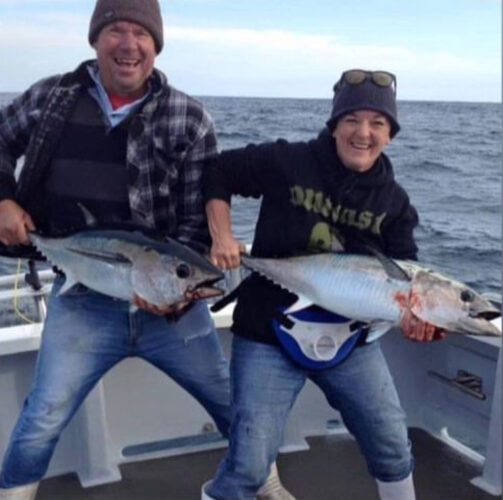
Tuna fun with Terry on a charter in Port MacDonell SA
On a land based trip recently to the Coburg Peninsula in Arnhem Land, I managed to sight cast a Tuna, jerking a popper over the top of the water and successfully hooking the fish. Landing it was a different story- I battled it all the way in to the beach before it took one long freight train out to sea and busted me off. It was an exhilarating experience. The adrenaline really gets going when you can see a fish chasing your lure in clear water and then bang you get the bite and the water explodes before you!
Poppers and stick baits are great options to cast out when you can see surface activity and tuna busting up, either from the land or on your own boat. If you want to have a go at surface lure fishing there are a myriad of videos online that demonstrate different techniques and styles of winding in your lure.
I have a favourite quality Okuma Pressure Point rod that’s designed for long casting and tackling hard pulling fish and it’s always in my kit when we travel but also out on the boat, in case we come across Tuna or Kingies on the surface. You can also jig with it too, it’s paired with a great 8000 size reel.
In very recent years we have discovered a Southern Bluefin Tuna fishery right on our doorstep, as they have been hanging around our coastline out the front of the Eastern Entrance of San Remo where we live. In fact, they turn up right along Victorian shores often following large schools of bait and while the bait hangs around, so do the fish!
The tuna are turning up here each year now, with each run activating a flotilla of charter boats targeting them, including some ladies charters which I am privileged to organise! It’s thrilling to witness another female catch her very first Tuna, often a bucket list fish for so many.
The school Tuna tend to turn up here between December and March, which is when I have run the ladies charters targeting them, mostly by trolling. It’s also the time of year when Terry and I are likely to look for some for ourselves, on our 5.5m boat.
The winter months between April and July are now seeing big barrel Tuna being caught here as well and they can be well over 100kgs. The winter can also mean big swells and less than favourable conditions, so if you are starting out I would suggest the summer fishery on calmer days!
There is always a possibility of a really big Tuna jumping on your hook so don’t skimp on gear. You need a heavy duty rod that can handle the power and weight of the fish. Anywhere between 15-24KG line class. 6-8ft long.
We have shorter boat rods for trolling and longer rods for casting. You can use big overhead reels or good quality spin reels. We have a mix of both. Reel size could be anywhere from a good quality spin reel 4000 -8000 for casting and trolling up to a 10,000 – 15,000 overhead.
Your local tackle shop should be able to point you in the right direction for a good combo that will handle Tuna.
We use wind on leaders which you can purchase or make yourself. We run 80-100lb leader, around 2 metres from the main line to the lures, and mostly use monofilament on our overheads, but we do have some braid on our spin reels.
There are various methods of targeting Tuna, specifically the Southern Bluefin variety. You can troll for them, towing around skirted lures and divers in various sizes and colours, including teasers like spreader bars/daisy chains and witch doctors. Stopping your boat to cast top water lures at fish busting up on the surface is an option, you can jig for them and you can also cube a pilchard trail out and float a pilly down on a hook. Trolling is probably the most common method.
When trolling, both recreationally and on the charter boat, we have had the best success using the smaller skirted lures around the 6 inch size. Skirted lures can range up to 15 inches long.
There is no reason small skirts wont work on even bigger fish as essentially you are imitating bait. As long as you have a sharp quality hook. We have a lot of success on pinks, blues and lumo when it comes to colours. I’m guessing it’s how the light plays on them and how natural they imitate bait in the area, for example Whitebait or Pilchard. Larger Skirts would however be used as well when targeting bigger Barrel Tuna.
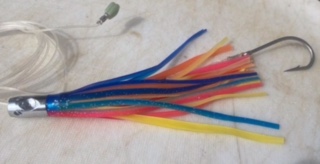
An example of a skirted lure. A good quality hook is essential.
We also have a lot of success on our pink spreader bar which we like to run a fair way out the back of our lure spread, in the shotgun position. You need to be mindful of other boats nearby if using this method, you don’t want to cut across their trolling area or vice versa, especially if a lot of boats are trying to work the one area of activity.
A spreader bar imitates a school of baitfish on the surface and causes a buzz of activity in your wake that attracts the tuna.
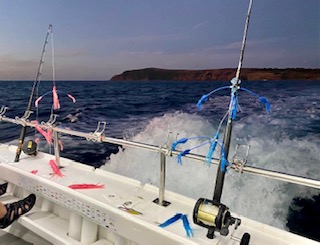
Spreader bars ready to be deployed on the charter boat on solid boat rods with overhead reels
A spread of lures trolled out the back of the boat usually involves 5 lures. Some boats, especially bigger game boats, use outrigger poles to get their lines out wider in the clear water outside of the boat wake.
When trolling a ‘spread’ of lures you have a short corner and a long corner, a short rigger and a long rigger and furthest out the back is the shotgun position, which is our preferred spot for a spreader bar so it doesn’t get tangled up, but you can run a spreader bar off one corner too. The rod for the Shotgun position is usually above our heads in the overhead bimini rack.
Having your lures set at different lengths stops tangles and creates different bubble trails and effects in different parts of the wake to excite fish. It’s important to watch your lures when you first set them out to check they are not bouncing off the water but rather kicking up a good little splash. We are always watching the spread as we travel, for tangles or weed getting on a lure. This is where if you have a crew you put them to work on watch!
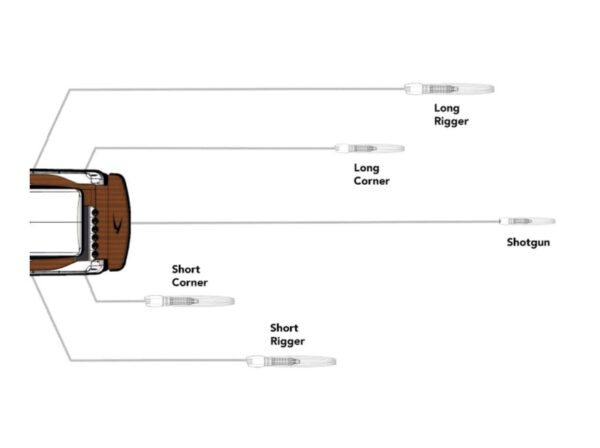
Diagram of lure spread positions courtesy of Black Magic Tackle
Trolling Speed can be anywhere between 6-10 knots for us and sometimes it’s hard to keep momentum if the swell is especially big. The conditions will play a part in the speed you choose and it’s more about getting the lures to swim effectively. If you want to mix in divers as well as skirted lures you will have to experiment to find the happy medium where both sets of lures tow nicely in the water. If we run deep divers they would normally be in the short corners so they are below the prop wash.
One of our favourite go to divers is called a King Brown and we also love the Pilchard colour in divers. Sometimes you will get all your fish on skirts and next time it will be the divers, so you have to be prepared to swap out lures and experiment in your spread. You may also pick up Kingfish whilst trolling for Tuna. A very favourable bycatch!
The style and size of a bib or lip on the front of the divers determines the swimming action and depth of the lure. Deep diving lures are suited better to trolling. There are so many colours and styles on the market and it can take a lot of experimentation till you find your favourites that have success. If you are just starting out it’s a good tip to look for the manufacturer’s recommended trolling speed so your lure will swim effectively. Again, ask your local tackle shop about what seems to be working locally!
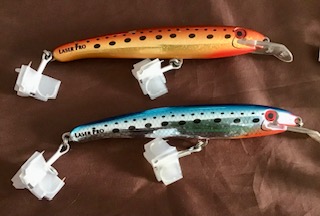
Examples of diving lures. If you’re planning to release the fish, swap out the treble hooks for single hooks.
When we go hunting for Tuna they can be just around the corner from the Entrance, outside local places like the Glasshouse, or off Kilcunda but then they can also be 30km away down towards Cape Paterson and Harmers Haven or the other way towards Flinders Bank. It’s good to try and get a heads up on where they have been caught recently and how regularly it’s happening before you gamble your hard earned dollars on fuel!
If you support your local tackle shop they may just give you some intel! Social media usually gives a few clues too. If we see lots of reports of local tuna being caught on social media then we know the odds of snaring one have improved! It’s also handy if you have other mates on the water who will give you a ring if they find them or vice versa. We have mostly caught them in around the 30m-50m line/depth of water.
Blindly trolling without a plan and knowing what to look for can be akin to running out the front of your house and chucking $100 notes down the drain, it can be very costly as you burn up fuel travelling around the big ocean looking for fish!
We always look for bird activity- Mutton birds, Gulls, Gannets and Terns can be your best friend on the water. Birds have amazing eyesight and can see fish and bait from a great height. They will circle and dive and can point you in the direction to where the action is. You can come across acres of Shearwaters on the water but there is a difference between them being ‘parked up’, having already fed or waiting to feed as opposed to actively working a patch of bait.
There is nothing more exciting than seeing the Mutton birds rolling forward as they dive to eat bait on the surface. This is a great indicator of bigger fish like Tuna underneath driving the bait upwards. We study the direction the birds are moving and try to get well ahead of them with our boat to intersect the fish with our lures as they come through. We are always looking for Mutton birds with their heads in the water!

Mutton birds (also known as Shearwaters) feeding on a bait school
We never cut across the raft of Mutton birds working as this will only send the bait down and scare off the bigger fish. It is very frustrating and poor etiquette when you see boats ignorantly cut across a raft of working birds. It is better to troll alongside the raft or get way out in front of the direction they are moving. It’s always better to steer well away from other boats and not cut across each other’s lure spread.
Sometimes you will have a whole ‘zoo’ of ocean life in a frenzy, when there is a lot of bait on the surface and bigger fish underneath. You can have Terns and Gannets diving, seagulls lifting up and down off the water feeding, penguins, seals, dolphins and we have even had a whale in the throng!
The polar opposite to this is seeing one lone bird like a big Gannet dive on the water in the middle of nowhere and there has been bait on the sounder and tuna underneath. Either way we use the birds as indicators to activity and a great place to start trolling our spread of lures around.
Sometimes we will actually see Tuna busting up and jumping clear out the water. Other times we will see what we call ‘nervous’ water. It stands out from the rest of the surface as it has tell-tale ripples indicating fish or bait underneath. Often when you get alongside it you will see the fish or bait right at the top of the water column.
Your sounder comes in to play, showing up bait and fish underneath the bait. The depth shows you if the fish or bait are up near the surface or way down on the bottom. When trolling skirted lures or divers you need to take into account how deep they go and if they will reach what you see on the screen, give or take. If it’s nice clear water the fish will see the lure and come up a bit as well.
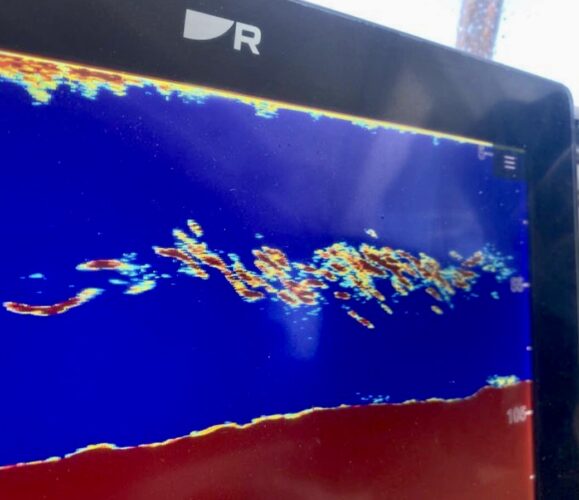
A massive school of Tuna on the sounder, with bait fish showing at the top of the screen
If you are lucky to hook up, try to mark the spot on your GPS and then keep working that area in up to a 1km radius, first in the same direction you hooked up in and then in different directions. We have found sometimes our hook-ups are all in the same direction, which is possibly the light angle on the lures.
If you have birds in the area keep an eye on where they are heading and what they are doing, but don’t get sucked into a wild goose chase across the ocean. Never drive away from bait and fish on your screen. If we found a lot of bait on the screen but no obvious fish, we would probably troll the area in a 1km radius looking for fish before we moved on.
When it all comes together and a rod buckles and we hear line peel off, one of us usually yells “fish on”!
We don’t stop the boat immediately but continue for 10-15 seconds or so to give the other lures a chance to be hit as well in a ‘multiple hook up’, remembering they are a school fish! If you can find time to mark your position on your plotter you can continue to work the area after you have landed your fish. It’s amazing how quick you move/drift from where you first hooked up whilst you are busy attending to rods and landing a fish.
Once the lure spread is back in the water try to approach the spot where you hooked up in the same direction, so your lures look the same in the light as the first time, in the hope you come across the school again. Then do figure 8s of the area up to a kilometre in radius. You may also have birds working the area showing you where the school has moved to.
Whilst I haven’t always used one, a gimble and harness is a great back saver and especially helpful for heavier fish. It saves the rod sticking into your body and you can concentrate on a slow and steady lift and wind down action to get your fish successfully boat side. They are a great investment in your kit.
Bringing in a Tuna can require some muscle work and sometimes the bigger models can be helped in to the boat quicker if you have a good boat driver who can move the boat(often reversing) in the right direction to assist you with your line angle and make it less tiresome and quicker to land the fish. The faster you can get your fish into the boat the better for the angler and the fish.
The Tuna will at times power off and take line but you just keep lifting up and winding down in continuous short pumps when he stops. As I read somewhere, one of two things should be happening at all times, either you are winding or the fish is pulling line! In other words, don’t stop! It’s important not to lift your rod too high and put too much pressure on the rod tip. No higher than level with your own head perhaps.
Team work definitely makes the dream work in Tuna fishing. Once you get your fish boat side you need someone competent on the gaff. If they miss, the fish is likely to take off flat out. The quicker the fish is in, the better quality of the meat as Tuna heat up as their muscles work or if you want to release the fish its best to minimise a long drawn out battle. It’s great if someone can grab the leader to help swim the tuna right up beside the boat ready to be gaffed. If there are only two of you on board and you are both on a fish you may need to get creative with the juggle!
Working in a team can mean you are both battling a multiple hook up or one is bringing in the other lines and getting the gaff ready whilst the other is battling a fish. It can get very chaotic very fast!
In looking after your Tuna I cannot recommend Tuna Champions highly enough as a resource to educate yourself on the best Tuna handling and dispensing methods. Tuna Champions are scientifically backed and will show you how to keep your prized fish in tip top condition. Getting the fish to the boat is just the start of the journey to a top quality eating fish or a successful release.
Once brain spiked and bled out, we immediately ice our fish, either in a large esky or keeper bag.
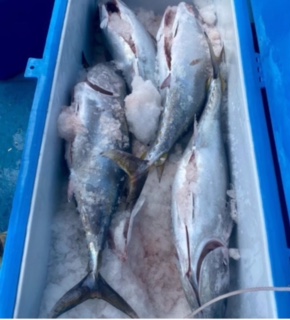
Tuna on ice, with ice up in their belly cavities to speed up the chilling process
Every season we keep our first few Tuna, as we especially love to eat it fresh and to also smoke a heap of Tuna pieces, especially the belly and to cryovac the fish so it will keep for the next few months in the fridge. Sometimes we also preserve Tuna in Oil. I’ve previously written about some of my favourite ways to prepare Tuna.
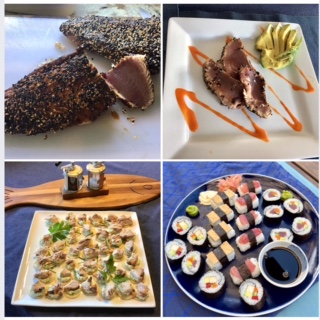
There are 101 ways to eat tuna!
I have had ladies use the heads for fish stock and one even makes tuna jerky in her dehydrator for her dogs. The less that is wasted from the fish, the better. There are hundreds of ways to use Tuna!
Remember you may not be able to learn to play a piano but you can Tuna fish!
Learn more about fishing for tuna via the VFA’s Recreational Fishing guide.

